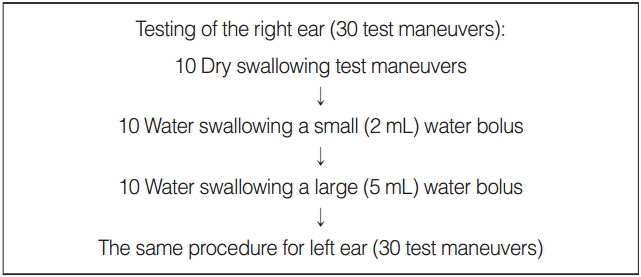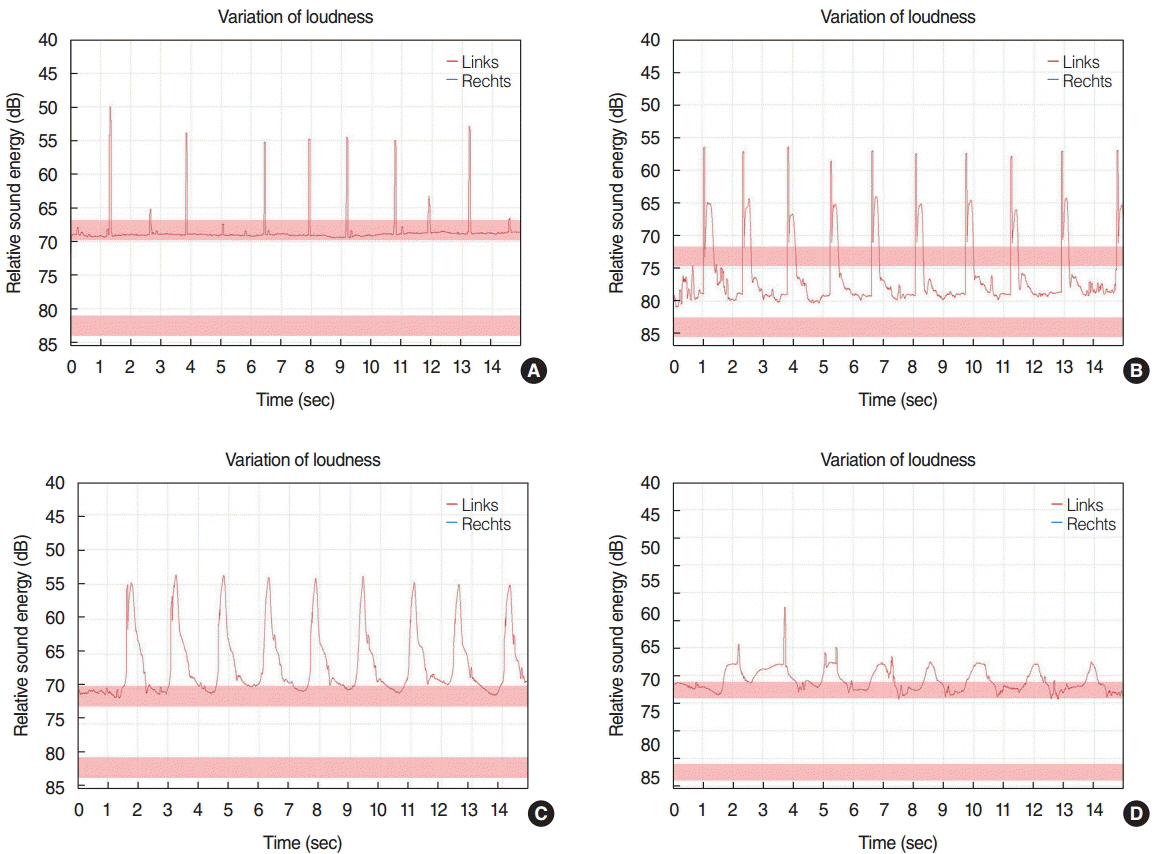Clin Exp Otorhinolaryngol.
2016 Jun;9(2):116-122. 10.21053/ceo.2015.00626.
Eustachian Tube Opening Measurement by Sonotubometry Using Perfect Sequences for Healthy Adults
- Affiliations
-
- 1Clinic of Ear, Nose, Throat and Eye Diseases, Faculty of Medicine, Vilnius University, Vilnius, Lithuania. vilmabeleskiene@gmail.com
- 2Center of Ear, Nose and Throat Diseases, Vilnius University Hospital Santariskiu Clinics, Vilnius, Lithuania.
- 3Faculty of Mechanics, Vilnius Gediminas Technical University, Vilnius, Lithuania.
- KMID: 2165053
- DOI: http://doi.org/10.21053/ceo.2015.00626
Abstract
OBJECTIVES
The aim of this study was to establish the rate variation of sonotubometric measurements using a specific broadband class of signals, the so-called perfect sequences (PSEQ) among healthy adults and to identify an optimal and technically simple test to provoke Eustachian tube (ET) openings.
METHODS
Sonotubometry was performed on 105 healthy adult subjects. Three different consecutive maneuvers were performed for ET opening: dry swallowing, water swallowing (a small [2 mL] and a large [5 mL] water bolus). Values of the amplitude and duration of each measured ET opening were calculated.
RESULTS
A total of 6,300 measurements were performed. Sonotubometric ET openings were detected for all subjects but not for each measurement. In 6,180 of 6,300 measurements (98.1%), objective ET openings were registered. In 11 of 105 subjects (10.5%) at least one sonotubometric ET opening was not detected. The mean ET opening duration time and the mean sound amplitude similar for all performed test and were 270 (SD, ±96) msec, 13.48 (SD, ±6.57) dB.
CONCLUSION
Sonotubometry based on PSEQ stimuli is a reliable methodology to assess the ET opening function in healthy subjects. Mean ET opening duration time and the mean sound wave amplitude performed similarly in all analysed tests, hence it might be concluded that dry (saliva) and water swallowing are reliable sonotubometric maneuvers and may be used when examining ET opening function. The size of a sip during water swallowing does not affect the sonotubometry result. All maneuvers can be equally used as the optimal test, and water swallow is most comfortable for the subject.
Keyword
MeSH Terms
Figure
Reference
-
1. Ockermann T, Reineke U, Upile T, Ebmeyer J, Sudhoff HH. Balloon dilation eustachian tuboplasty: a feasibility study. Otol Neurotol. 2010; Sep. 31(7):1100–3.2. Martino E, Di Thaden R, Krombach GA, Westhofen M. Function tests for the Eustachian tube: current knowledge. HNO. 2004; Nov. 52(11):1029–39.3. Browning GG, Gatehouse S. The prevalence of middle ear disease in the adult British population. Clin Otolaryngol Allied Sci. 1992; Aug. 17(4):317–21.
Article4. McDonald MH, Hoffman MR, Gentry LR, Jiang JJ. New insights into mechanism of Eustachian tube ventilation based on cine computed tomography images. Eur Arch Otorhinolaryngol. 2012; Aug. 269(8):1901–7.
Article5. Bluestone CD. The Eustachian tube: structure, function, and role in the middle ear. Hamilton (CA): BC Decker Inc.;2005.6. Marchioni D, Mattioli F, Alicandri-Ciufelli M, Presutti L. Prevalence of ventilation blockages in patients affected by attic pathology: a case-control study. Laryngoscope. 2013; Nov. 123(11):2845–53.
Article7. Leuwer R, Schubert R, Wenzel S, Kucinski T, Koch U, Maier H. New aspects of the mechanics of the auditory tube. HNO. 2003; May. 51(5):431–7.8. van Heerbeek N, Ingels KJ, Snik AF, Zielhuis GA. Reliability of manometric eustachian tube function tests in children. Otol Neurotol. 2001; Mar. 22(2):183–7.
Article9. Groth P, Ivarsson A, Tjernstrom O. Reliability in tests of the Eustachian tube function. Acta Otolaryngol. 1982; 93(1-6):261–7.
Article10. Bluestone CD, Cantekin EI. Current clinical methods, indications and interpretation of eustachian tube function tests. Ann Otol Rhinol Laryngol. 1981; Nov-Dec. 90(6 Pt 1):552–62.
Article11. van der Avoort SJ, van Heerbeek N, Zielhuis GA, Cremers CW. Sonotubometry: eustachian tube ventilatory function test. A state-of-the-art review. Otol Neurotol. 2005; May. 26(3):538–43.
Article12. Virtanen H. Sonotubometry: an acoustical method for objective measurement of auditory tubal opening. Acta Otolaryngol. 1978; Jul-Aug. 86(1-2):93–103.13. Holmquist J, Bjorkman G, Olen L. Measurement of eustachian tube function using sonotubometry. Scand Audiol. 1981; Feb. 10(1):33–5.
Article14. Okubo J, Watanabe I, Shibusawa M, Ishikawa N, Ishida H, Teramura K. Sonotubometric measurement of the eustachian tube function by means of band noise: a clinical view of the acoustic measurement of the eustachian tube. ORL J Otorhinolaryngol Relat Spec. 1987; Feb. 49(5):242–52.15. Jonathan D. The predictive value of eustachian tube function (measured with sonotubometry) in the successful outcome of myringoplasty. Clin Otolaryngol Allied Sci. 1990; Oct. 15(5):431–4.
Article16. Mondain M, Vidal D, Bouhanna S, Uziel A. Monitoring eustachian tube opening: preliminary results in normal subjects. Laryngoscope. 1997; Oct. 107(10):1414–9.
Article17. Di Martino EF, Thaden R, Antweiler C, Reineke T, Westhofen M, Beckschebe J, et al. Evaluation of Eustachian tube function by sonotubometry: results and reliability of 8 kHz signals in normal subjects. Eur Arch Otorhinolaryngol. 2007; Mar. 264(3):231–6.18. Asenov DR, Nath V, Telle A, Antweiler C, Walther LE, Vary P, et al. Sonotubometry with perfect sequences: first results in pathological ears. Acta Otolaryngol. 2010; Nov. 130(11):1242–8.
Article19. Di Martino EF, Nath V, Telle A, Antweiler C, Walther LE, Vary P. Evaluation of Eustachian tube function with perfect sequences: technical realization and first clinical results. Eur Arch Otorhinolaryngol. 2010; Mar. 267(3):367–74.
Article20. Poe DS, Abou-Halawa A, Abdel-Razek O. Analysis of the dysfunctional eustachian tube by video endoscopy. Otol Neurotol. 2001; Sep. 22(5):590–5.
Article21. Poe DS, Grimmer JF, Metson R. Laser eustachian tuboplasty: two-year results. Laryngoscope. 2007; Feb. 117(2):231–7.
Article22. Schloegel L, Gottschall JA. Balloon dilation of the Eustachian tube: safety and utility. Otolaryngol Head Neck Surg. 2009; Sep. 141(3S1):134.23. Poe DS, Silvola J, Pyykko I. Balloon dilation of the cartilaginous Eustachian tube. Otolaryngol Head Neck Surg. 2011; Apr. 144(4):563–9.
Article24. Takasaki K, Sando I, Balaban CD, Miura M. Functional anatomy of the tensor veli palatini muscle and Ostmann’s fatty tissue. Ann Otol Rhinol Laryngol. 2002; Nov. 111(11):1045–9.
Article25. Gaihede M, Dirckx JJ, Jacobsen H, Aernouts J, Sovso M, Tveteras K. Middle ear pressure regulation: complementary active actions of the mastoid and the Eustachian tube. Otol Neurotol. 2010; Jun. 31(4):603–11.26. Bylander A, Tjernstrom O, Ivarsson A. Pressure opening and closing functions of the eustachian tube in children and adults with normal ears. Acta Otolaryngol. 1983; Jan-Feb. 95(1-2):55–62.
Article27. Honjo I. Eustachian tube in middle ear diseases. New York: Springer;1988.28. Munro KJ, Benton CL, Marchbanks RJ. Sonotubometry findings in children at high risk from middle ear effusion. Clin Otolaryngol Allied Sci. 1999; Jun. 24(3):223–7.
Article29. van der Avoort SJ, Heerbeek Nv, Zielhuis GA, Cremers CW. Validation of sonotubometry in healthy adults. J Laryngol Otol. 2006; Oct. 120(10):853–6.
Article30. van der Avoort SJ, van Heerbeek N, Snik AF, Zielhuis GA, Cremers CW. Reproducibility of sonotubometry as Eustachian tube ventilatory function test in healthy children. Int J Pediatr Otorhinolaryngol. 2007; Feb. 71(2):291–5.
Article
- Full Text Links
- Actions
-
Cited
- CITED
-
- Close
- Share
- Similar articles
-
- A Case of Subcutaneous Emphysema and Pneumomediastinum After Balloon Eustachian Tuboplasty
- Eustachian Tube Function Test
- Immunohistochemical Localization of Insulin-Like Growth Factor-I in the Eustachian Tube of the Rat
- A Case of Collagen Graft for Patulous Eustachian Tube
- Distribution of Mast Cells in the Rat Tympanic Membrane and Eustachian Tube



